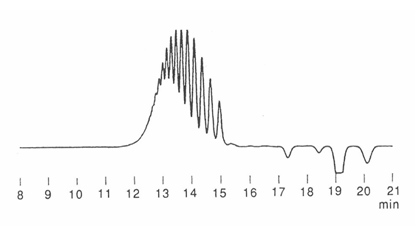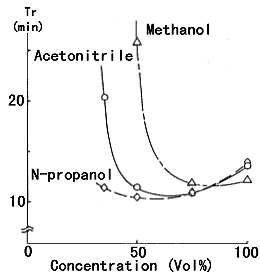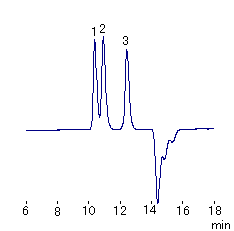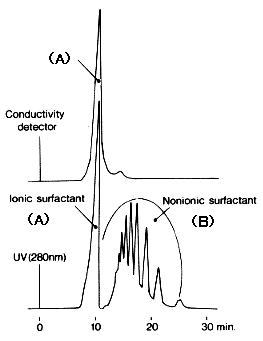Surfactants
Surfactants are categorized by their chemical structure into ionic and nonionic surfactants, but are characterized by the common feature that one molecule contains both hydrophilic and hydrophobic portions. Taking advantage of such a common feature, Asahipak GF-310 HQ, a multisolvent GPC column, facilitates a wider range of separation for a variety of surfactants, which cannot be done by ODS columns. The separation can be made simply adjusting the concentration of the organic solvent or the salt in the eluent according to the purpose of the analysis. Moreover, since GF-310 HQ hardly swell or shrink in organic solvents, most of organic solvents can be used as the eluent and GF-310 HQ can be used for the analysis of surfactants of wide hydrophobicity range.
Nonionic Surfactants
Nonylphenol ethoxylate was analyzed using Asahipak GF-310 HQ ( a multisolvent GPC column ). The elution pattern is completely different according to the acetonitrile concentration.

Sample : 100ppm Nonylphenol ethoxylate, 20micro-L
Column : Shodex Asahipak GF-310 HQ (7.5mmID*300mm) Eluent : H2O/CH3CN Flow rate : 0.6mL/min Detector : UV(220nm) Column temp. : 40deg-C
Nonylphenol ethoxylates were analyzed using MSpak GF-310 4E ( a multisolvent GPC column ). GF-310 4E is useful for analysis of surfactants getting rid of the influence of impurities such as oil, pigment and sulfur because of Size Exclusion Chromatography effects. The reasons of the effect are following.
1) Oil and pigment are eluted at first for their high molecular weight.
2) Sulfur is eluted later than surfactants for its low molecular weight.

Sample : 5micro-L
1. Corn oil
2. Nonylphenol ethoxylates 100ppm
3. Nonylphenol 50ppm
4. Nonylphenoxy acetic acid 100ppm
5. Nonylphenol monoethoxy acetic acid 100ppm
6. Nonylphenol diethoxy acetic acid 100ppm
7. Sulfur
Column : Shodex MSpak GF-310 4E (4.6mmID*250mm) Eluent : 50mM CH3COONH4/CH3CN=10/90 Flow rate : 0.3mL/min Detector : UV(220nm) Column temp. : 40deg-C
Nonylphenol ethoxylates were analyzed using MSpak GF-310 4E (a multisolvent GPC column). Nonylphenol ethoxylates are eluted by their poler using gradient solvent system.

Sample : 5micro-L
1. Nonylphenol ethoxylates (NPnEO)
2. Nonylphenol (NP)
Column : Shodex MSpak GF-310 4E (4.6mmID*250mm)
Eluent : (A); CH3CN (B); H2O
0min to 26min to 33min to 48min, A/B= 26/74 to 50/50 to 90/10 to 90/10
Flow rate : 0.5mL/min
Detector : Fluorescence detector(Ex.225nm, Em.300nm)
Column temp. : 40deg-C
A nonionic surfactant was analyzed using Asahipak GF-310 HQ ( a multisolvent GPC column ). Octylphenol ethoxylate is a surfactnt which is widely used in biochemical fields as well.

Sample: 100ppm, 20micro-L
Octylphenol ethoxylate
Column : Shodex Asahipak GF-310 HQ (7.5mmID*300mm) Eluent : CH3CN/H2O=35/65 Flow rate : 0.6mL/min Detector : UV(280nm) Column temp. : 40deg-C
Polyoxyethylene (2) isooctylphenyl ether (IGEPAL® CA-210), which is a nonionic surfactant, was analyzed using organic GPC KF-402HQ. KF-402 HQ is a high resolution semi-micro column that has approximately 1.5 times better theoretical plate number compared with a standard one.

Sample :10micro-L
IGEPAL® CA-210, Polyoxyethylene (2) isooctylphenyl ether, 1%
Column : Shodex GPC KF-402HQ (4.6mmID*250mm) x 2 Eluent : THF Flow rate : 0.3mL/min Detector : Shodex RI (small cell volume) Column temp. : 40deg-C
Polyoxyethylene (4) lauryl ether (Brij® 30), which is a nonionic surfactant, was analyzed using organic GPC KF- 402HQ. KF-402 HQ is a high resolution semi-micro column that has approximately 1.5 times better theoretical plate number compared with a standard one.

Sample : 10micro-L
Brij® 30, Polyoxyethylene (4) lauryl ether 2%
Column : Shodex GPC KF-402HQ (4.6mmID*250mm) x 2 Eluent : THF Flow rate : 0.3mL/min Detector : Shodex RI (small cell volume) Column temp. : 40deg-C
Polyoxyethylene (2) cetyl ether (Brij® 52), which is a nonionic surfactant, was analyzed using organic GPCKF- 402HQ. KF-402 HQ is a high resolution semi-micro column that has approximately 1.5 times better theoretical plate number compared with a standard one.

Sample : 10micro-L
Brij® 52, Polyoxyethylene (2) cetyl ether 2%
Column : Shodex GPC KF-402HQ (4.6mmID*250mm) x 2 Eluent : THF Flow rate : 0.3mL/min Detector : Shodex RI (small cell volume) Column temp. : 40deg-C
Polyoxyethylene (4) lauryl ether (Brij® 30) which is a nonionic surfactant was analyzed using Asahipak GF-310 HQ ( a multisolvent GPC column ). The component of which polyethylene chain is longer elutes faster.

Sample : 1%, 20micro-L
Brij® 30, Polyoxyethylene (4) lauryl ether
Column : Shodex Asahipak GF-310 HQ (7.5mmID*300mm) Eluent : CH3CN/H2O=45/55 Flow rate : 0.6mL/min Detector : Shodex RI Column temp. : 40deg-C
Polyoxyethylene cetyl ether(Brij® 56) which is a nonionic surfactant was analyzed using Asahipak GF-310 HQ ( a multisolvent GPC column ). The component of which polyethylene chain is longer elutes faster.

Sample : 1%, 20micro-L
Brij®56, Polyoxyethylene cetyl ether
Column : Shodex Asahipak GF-310 HQ (7.5mmID*300mm) Eluent : CH3CN/H2O=60/40 Flow rate : 0.6mL/min Detector : Shodex RI Column temp. : 40deg-C
Nnonylphenol ethoxylate, a nonionic surfactant was analyzed using Asahipak GF-310 HQ (a multisolvent GPC column).
The figure shows the effect of organic solvent concentartion on elution time for Nnonylphenol ethoxylate of different degree of POE polymerization.
The elution characterstics of Nnonylphenol ethoxylate are different in the following three areas:
Area 1
The organic solvent concentration is lower than 20%. In this area, surfactants are adsorbed on the packing material and no peak appears in the chromatogram.
Area 2
The organic solvent concentration is medium, 20 to 60%. Surfactants are reteined by mainly hydrophobic interaction with packing maetrials and can be separated each other.
Area 3
The organic solvent concentration is higher than 60%. Surfactants cannot be retained by hydrophobic interaction with packing materials and elute as the single peak. This condition is good for microchemical analysis of trace of components.
Moreover, the elution characterstics of surfactants using GF-310 HQ has important features as follows:
1) The recoveries of surfactants are very high unless they are adsorbed. Refer to the table.
2) The surfactant of which molecular weight is larger elutes faster.

| Degree of POE Polymerization(n) |
Acetonitrile Concentration (%) | ||||
|---|---|---|---|---|---|
| 0 | 25 | 50 | 75 | 100 | |
| 100 | Adsorption | 100 | 100 | 100 | 100 |
| 60 | Adsorption | 80 | 100 | 100 | 100 |
| 45 | Adsorption | Adsorption | 100 | 100 | 100 |
| 20 | Adsorption | Adsorption | 100 | 100 | 100 |
| 10 | Adsorption | Adsorption | 100 | 100 | 100 |
Sample : Nnonylphenol ethoxylate
Column : Shodex Asahipak GF-310 HQ (7.5mmID*300mm) Flow rate : 0.6mL/min Detector : UV(280nm) Column temp. : 30deg-C
When analyzing nonylphenol ethoxylate is analyzed using Asahipak GF-310 HQ ( a multisolvent GPC column ), elution characteristics are different according to the degree of POE polymerization because hydrophilicity of the sample is different according to the length of POE chain. For the sample of n=5, a good chromatogram can be obtained with 50% acetonitrile. However, for the sample of n=10, a poor chromatogram can be obtained with 50% acetonitrile and a good chromatogram can be obtained with 30% acetonitrile.

Sample : Nonylphenol ethoxylate, 20micro-L
(A),(B) ; 50ppm
(C) ; 100ppm
Column : Shodex Asahipak GF-310 HQ (7.5mmID*300mm) Eluent : CH3CN/H2O Flow rate : 0.6mL/min Detector : UV(220nm) Column temp. : (A),(B); 30deg-C, (C); 40deg-C
For the analysis of nonylphenol ethoxylate using Asahipak GF-310 HQ (a multisolvent GPC column), most of organic solvents can be used.
The figure shows the elution characteristics of nonylphenol ethoxylate when typical organic solvents are used. The elution time of nonylphenol ethoxylate is the fastest when n-propanol is used, medium when acetonitrile is used and the latest when methanol is used. The order is as same as the case when reversed phase columns are used.

Sample :
Nonylphenol ethoxylate (n=20)
Column : Shodex Asahipak GF-310 HQ (7.5mmID*300mm) Flow rate : 0.6mL/min Detector : UV(280nm) Column temp. : 30deg-C
Nonylphenol ethoxylater, a nonionic surfactant was analyzed using Asahipak GF-310 HQ (a multisolvent GPC column). The figure shows the chromatograms of different degree of POE polymerization. And, the table shows the elution time of the peaks.
Moreover, the elution characterstics of of alkylphenol ethoxylate and alkyl ethoxylate using GS-310 HQ has important features as follows:
1) The surfactant of which molecular weight is larger elutes faster.
2) The reproducibility of the elution time of the peaks are very good and are independent of the typical degree of POE polymerization of the sample.
These features are useful for the determination of the degree of POE polymerization.

| Typical degee of POE polymerization(n) |
Degee of POE polymerization of the peak (n) |
|||||
|---|---|---|---|---|---|---|
| 10 | 6 | 4 | 3 | 2 | 1 | |
| Monomer | – | – | – | 20.80 | 27.06 | 35.07 |
| Dimer | – | 16.91 | 20.14 | 22.76 | 27.01 | 35.01 |
| Hexamer | 13.99 | 16.96 | 20.09 | 22.70 | 22.01 | – |
| Decamer | 14.15 | 16.91 | 19.99 | 22.70 | – | – |
Sample :
Nonylphenol ethoxylate
Column : Shodex Asahipak GF-310 HQ (7.5mmID*300mm) Eluent : CH3CN/H2O=30/70 Flow rate : 0.6mL/min Detector : UV(280nm) Column temp. : 30deg-C
The effect of temperature when POE distribution of octylphenyl ethoxylate (n=6) is measured using Asahipak GF-310 HQ ( a multisolvent GPC column) is shown here. Over the wide temperature range, good chromatograms are obtained. At high temperature, higher resolution is obtained because of sharp peak shape though the retention time is faster.

Sample : Octylphenyl ethoxylate
Column : Shodex Asahipak GF-310 HQ (7.5mmID*300mm) Flow rate : 0.6mL/min Eluent : CH3CN/H2O=60/40 Detector : UV(280nm) Column temp. : 15, 30, 60deg-C
The comparison of Asahipak GF-310 HQ ( a multisolvent GPC column ) and an ODS column when they were used for the measurement of POE distribution of octylphenol ethoxylate is shown here. When GF-310 HQ was used, good chromatograms were obtained using 35 and 40% acetonitrile concentration. On the other hand, when an ODS column was used, POE distribution can be measured using 55% acetonitrile concentration but the separation is not sufficient.

Sample :
Octylphenol ethoxylate
Column : Shodex Asahipak GF-310 HQ (7.5mmID*300mm) Eluent : CH3CN/H2O Flow rate : 0.6mL/min Detector : UV(280nm) Column temp. : 30deg-C Column : ODS column from the other manufacturer Eluent : CH3CN/H2O Flow rate : 0.8mL/min Detector : UV(280nm) Column temp. : 30deg-C
The comparison of Asahipak GF-310 HQ ( a multisolvent GPC column ) and an ODS column when they were used for the measurement of POE distribution of octylphenol ethoxylate is shown here. Comparing the retention times of peaks, we can say that octylphenol ethoxylate of different degree of POE polymerization can be separated by GF-310 HQ more sufficiently than by an ODS column.

Sample : Octylphenol ethoxylate
The comparison of Asahipak GF-310 HQ (a multisolvent GPC column) and an ODS column when they were used for the analysis of PEG (polyethylene glycol) is shown here.
When GF-310 HQ is used, the effect of acetonitrile concentration on elution time is rather small and the component of lager molecular weight elutes faster. Please refer to (A).
When an ODS column is used, the effect of acetonitrile concentration on elution time is very large and the component of smaller molecular weight elutes faster. The elution time can be shortened by increasing acetonitrile concentration. Please refer to (B).
When an ODS column is used for the analysis of surfactants, the effect of acetonitrile concentration on elution time is rather large and the component of lager molecular weight elutes faster. The elution time also can be shortened by increasing acetonitrile concentration. Please refer to (C).
From the results, we can say that the ODS column has hydrophobic interaction with both nonylphenyl groups and PEG and GF-310 HQ has hydrophobic interaction only with nonylphenyl groups. This difference is considered to be the cause of the difference in the measurement of POE distribution.

Sample :
(A),(B) PEG
(C) Nonylphenol ethoxylate
Column : (A) Shodex Asahipak GF-310 HQ (7.5mmID*300mm)
: (B),(C) ODS column from the other manufacturer
Eluent : CH3CN/H2O
Flow rate : (A); 0.6mL/min (B),(C); 0.8mL/min
Detector : (A),(B); Shodex RI (C); UV(280nm)
Column temp. : 30deg-C
Hydrophile-Lipophile Balance (HLB) was analyzed using Asahipak GS-310 7G ( a multisolvent GPC column ). HLB is one of the indicators representing the ratio of the hydrophilicity of a surfactant to its hydrophobicity. The HLB value and elution volume of octylphenol ethoxylate with a different polymerization degree show a good correlation. Therefore, it is possible to measure the HLB value from the elution volume.
GS-310 7G is an old type of GF-310 HQ.

Sample : Octylphenol ethoxylate
Column : Shodex Asahipak GS-310 7G (7.5mmID*500mm) Eluent : H2O/CH3CN=50/50 Flow rate : 1.0mL/min Detector : UV(280nm) Column temp. : 30deg-C
The Shodex multisolvent GPC columns display excellent performance in the sense that various types of eluent compositions can be used according to the sample composition. Aliphatic glycerides were analyzed using Asahipak GS-310 7G ( a multisolvent GPC column ) with chloroform as the eluent.
GS-310 7G is an old type of GF-310 HQ.

Sample :
1. Tripalmitin
2. Dipalmitin
3. Monopalmitin
Column : Shodex Asahipak GS-310 7G (7.5mmID*500mm) Eluent : CHCl3 Flow rate : 1.0mL/min Detector : Shodex RI Column temp. : 30deg-C
Glycerides were analyzed using Asahipak GF-310 HQ ( a multisolvent GPC column ).

Sample :
1. Tripalmitin
2. Dipalmitin
3. Monopalmitin
Column : Shodex Asahipak GF-310 HQ (7.5mmID*300mm) Eluent : THF Flow rate : 0.6mL/min Detector : Shodex RI Column temp. : 30deg-C
Triglyceride were analyzed using Asahipak GF-310 HQ (a multisolvent GPC column).

Sample : 0.5% each, 20micro-L
1. Tristearin
2. Tridecanoin, Tricaprin
3. Tributylin
4. Triacetin
Column : Shodex Asahipak GF-310 HQ (7.5mmID*300mm) Eluent : THF Flow rate : 0.6mL/min Detector : Shodex RI Column temp. : 30deg-C
Surfactant, Triton X-100 was analysed using RSpak RP18-613 ( a column for reversed phase chromatography ).

Sample : Triton X-100
Column : Shodex RSpak RP18-613 (6.0mmID*150mm) Eluent : CH3CN/THF/H2O=20/20/60 Flow rate : 1.3mL/min Detector : UV(254nm) Column temp. : 40deg-C
Triton X-100 was analyzed using OHpak SB-802.5 HQ ( a column for GFC separation ). Triton X-100 is polyethyrene glycol mono-p-iso-octylphenyl ether and one of sufactants. It is used in the field of bio-chemistry. Its phydrophillic part is polyethylene glycol and the elution order is the order of chain length of poly(ethylene glycol) form 1 to 15,16 in the conditions of (B) and (C).

Sample : Triton X-100
Column : Shodex OHpak SB-802.5 HQ (8.0mmID*300mm)
Eluent : (A); H2O/CH3CN=30/70
(B); H2O/CH3CN=70/30
(C); H2O/CH3CN=80/20
Flow rate : 0.5mL/min
Detector : UV(280nm)
Column temp. : 60deg-C
Multi-solvent (aqueous and organic) SEC column, Asahipak GF-310 HQ was used to analyze surfactant, polyoxethylene sorbitan monoleate.

Sample : 50micro-L
Polyoxyethylene sorbitan monooleate, Tween80 0.1%(w/v)
Column : Shodex Asahipak GF-310 HQ (7.5mmID*300mm) Eluent : CH3CN/H2O=70/30 Flow rate : 0.8mL/min Detector : UV(210nm), Shodex RI Column temp. : 40deg-C
Anionic Surfactants
Addition of approximately 50 mM of sodium nitrate or sodium chloride to an eluent and keeping in check effect of the electric charge of the sample make it possible to analyze anionic and cationic surfactants using Asahipak GS-310 7E (a multisolvent GPC column).
GS-310 7E ia an old type of GF-310 HQ.

Sample :
1. Sodium dodecylbenzenesulfonate
2. Glycerin
Column : Shodex Asahipak GS-310 7E (7.5mmID*250mm) Eluent : 50mM NaNO3 aq./CH3CN=40/60 Flow rate : 1.0mL/min Detector : Shodex RI Column temp. : 30deg-C
An anion surfactant was analyzed using Asahipak GF-310 HQ (a multisolvent GPC column). When anion surfactants were dissolved in aqueous solution, its anion part acts as surfactant. Anion surfactants are used in detergents and textile industries. Sodium dodecylbenzenesulfonate, an anion surfactant has two forms, soft type and hard type. And, it is important to distinguish the two forms from the enviromental point of view. GF-310 HQ can distinguish soft type and hard type quite easily. Several peaks can be observed for soft type and single peak can be observed for hard type.

Sample : 100ppm Sodium dodecylbenzenesulfonate, 20micro-L
Column : Shodex Asahipak GF-310 HQ (7.5mmID*300mm) Eluent : 50mM NaCl aq./CH3CN=50/50 Flow rate : 0.6mL/min Detector : UV(220nm) Column temp. : 30deg-C
Sodium alkyl sulfates were analyzed using Asahipak GF-310 HQ (a multisolvent GPC column). Since sodium alkyl sulfates have no UV absorption, an RI detector should be used for the detection.

Sample : 0.5%, 20micro-L
1. Sodium decyl sulfate
2. Sodium lauryl sulfate
Column : Shodex Asahipak GF-310 HQ (7.5mmID*300mm) Eluent : 50mM NaNO3 aq./CH3CN=50/50 Flow rate : 0.6mL/min Detector : Shodex RI Column temp. : 40deg-C
Sodium polyoxyethylene alkyl ether sulfoxide was analyzed with RSpak JJ-50 4D.

Sample : 0.1%, 5micro-L
Sodium poly oxyethylene alkyl ether sulfoxide
(Emal E-70C (Kao Corporation))
Column : Shodex RSpak JJ-50 4D (4.6mmID*150mm) Eluent : 25mM CH3COONH4 buffer(pH9.2)/CH3CN=50/50 Flow rate : 0.6mL/min Detector : Shodex RI Column temp. : 40deg-C
Each polyoxyethylene chain of nonylphenoxy carboxylic acids was analyzed by gradient elution with RSpak JJ-50 4D.

Sample : 1ppm Mixed nonylphenoxy carboxylic acids, 5micro-L
(Hayashi Pure Chemical Ind.,Co.,Ltd code.990-56063 Nonylphenoxy carboxylic acids mix (n=0 to 9))
1. Nonylphenoxy acetic acid
2. Nonylphenol monoethoxy acetic acid
3. Nonylphonol diethoxy acetic acid
4. Nonylphonol triethoxy acetic acid
5. Nonylphonol tetraethoxy acetic acid
6. Nonylphonol pentaethoxy acetic acid
7. Nonylphonol hexaethoxy acetic acid
8. Nonylphonol heptaethoxy acetic acid
9. Nonylphonol octaethoxy acetic acid
10. Nonylphonol nonathoxy acetic acid
Column : Shodex RSpak JJ-50 4D (4.6mmID*150mm)
Eluent : (A) 25mM CH3COONH4 buffer(pH9.5)/CH3CN=85/15
(B) 25mM CH3COONH4 buffer(pH9.5)/CH3CN=70/30
Linear gradient; 0min to 75min, (A) to (B)
Flow rate : 0.6mL/min
Detector : Fluorescence Detector(Ex. 225nm, Em. 300nm)
Column temp. : 40deg-C
Cationic Surfactants
Benzalkonium chloride was analyzed using Asahipak GF-310 HQ ( a multisolvent GPC column ). Since benzalkonium chloride has benzene ring in the molecule, it can be detected by a UV detector better than by an RI detector.

Sample: 100ppm(UV), 0.1%(RI), 20micro-L
Benzalkonium chloride
Column : Shodex Asahipak GF-310 HQ (7.5mmID*300mm) Eluent : CH3CN/50mM NaCl aq.=50/50 Flow rate : 0.6mL/min Detector : UV(220nm), RI Column temp. : 30deg-C
Addition of approximately 50 mM of sodium nitrate or sodium chloride to an eluent and keeping in check effect of the electric charge of the sample make it possible to analyze anionic and cationic surfactants using Asahipak GS-310 7G ( a multisolvent GPC column ).
GS-310 7G is an old type of GF-310 HQ.

Sample: Benzalkonium chloride
Column : Shodex Asahipak GS-310 7G (7.5mmID*500mm) Eluent : 50mM NaNO3/CH3CN=50/50 Flow rate : 1.0mL/min Detector : UV(254nm) Column temp. : 40deg-C
Benzalkonium chloride, a cationic surfactant was analyzed using OHpak SB-802.5 HQ ( a column for GFC separation ).

Sample : Benzalkonium chloride
Column : Shodex OHpak SB-802.5 HQ (8.0mmID*300mm) Eluent : 50mM NaNO3/CH3CN=65/35 Flow rate : 1.0mL/min Detector : UV(254nm) Column temp. : 60deg-C
Trimethylalkylammonium chlorides were analyzed using Asahipak GF-310 HQ (a multisolvent GPC column).

Sample : 0.5%, 20micro-L
Trimethyl dodecylammonium chloride
Trimethyl cetylammonium chloride
Column : Shodex Asahipak GF-310 HQ (7.5mmID*300mm) Eluent : 50mM NaNO3 aq./CH3CN=50/50 Flow rate : 0.6mL/min Detector : Shodex RI Column temp. : 30deg-C
Trimethylbenzylammonium chloride, a cationic surfactant was analyzed using OHpak SB-802.5 HQ ( a column for GFC separation ).

Sample :
Trimethylbenzylammonium chloride
Column : Shodex OHpak SB-802.5 HQ (8.0mmID*300mm) Eluent : 50mM NaNO3/CH3CN=65/35 Flow rate : 1.0mL/min Detector : UV(254nm) Column temp. : 60deg-C
A mini-column, Asahipak GF-310 HQ (4.6mmID*100mm)used for microchemical analysis.

Sample : (a); 5micro-M each, (b); 0.5micro-M each
1. DTMA+, n-Dodecyltrimethylammonium ion
2. CTMA+, Cetyltrimethylammonium ion
3. TDDBA+, Tetradecyldimethylbenzylammonium ion
4. TMSA+, Trimethylstearylammonium ion
Column : Shodex Asahipak GF-310 HQ (4.6mmID x 100mm) Eluent : 0.4mM 4,4'-Dipyridyl-0.8mM HCl(CH3CN 27%) Flow rate : 0.6mL/min Detector : Suppressed conductivity Column temp. : 40deg-C
Different Kinds of Surfactants
Sodium dodecyl sulfate and Triton X-100 were analyzed using OHpak SB-802.5 HQ (a column for GFC separation).

Sample :
(A) Sodium dodecyl sulfate
(B) Triton X-100
Column : Shodex OHpak SB-802.5 HQ (8.0mmID*300mm) Eluent : H2O/CH3CN=70/30 Flow rate : 1.0mL/min Detector : UV(254nm) Column temp. : 60deg-C
With Asahipak GS-310 7G (a multisolvent GPC column), a nonionic surfactant coexisting with an ionic surfactant can be measured separately from the ionic surfactants. Since the column is packed with a gel which has slight amount of carboxyl group, the ionic substance is excluded first when an eluent containing no salt is used.
GS-310 7G is an old type of GF-310 HQ.

Sample : 5ppm each, 25micro-L
(A) Octylphenol ethoxylate sulfate, Polyoxyethylene octylphenyl ether sulfate
(B) Octylphenol ethoxylate, Polyoxyethylene octylphenyl ether
Column : Shodex Asahipak GS-310 7G (7.5mmID*500mm) Eluent : H2O/CH3CN=60/40 Flow rate : 1.0mL/min Detector : UV(280nm), Non-suppressed conductivity Column temp. : 30deg-C
Separation of ionic surfactant (sodium dodecylbenzenesulfonate and benzalkonium chloride) and non-ionic surfactant(polyoxyethylene octylphenyl ether) using Asahipak GF-310 HQ (a multisolvent GPC column) is shown here. The upper two chromatograms show the separation of two substances, sodium dodecylbenzenesulfonate and polyoxyethylene octylphenyl ether (left) and benzalkonium chloride and polyoxyethylene octylphenyl ether (right). The lower chromatogram shows the separation of three substances, sodium dodecylbenzenesulfonate, benzalkonium chloride and Polyoxyethylene octylphenyl ether.


Sample : 50ppm each, 20micro-L
A. Sodium dodecylbenzenesulfonate
B. Benzalkonium chloride
C. Polyoxyethylene octylphenyl ether
Column : Shodex Asahipak GF-310 HQ (7.5mmID*300mm) Eluent : H2O/CH3CN=50/50 Flow rate : 0.6mL/min Detector : UV(220nm) Column temp. : 30deg-C
